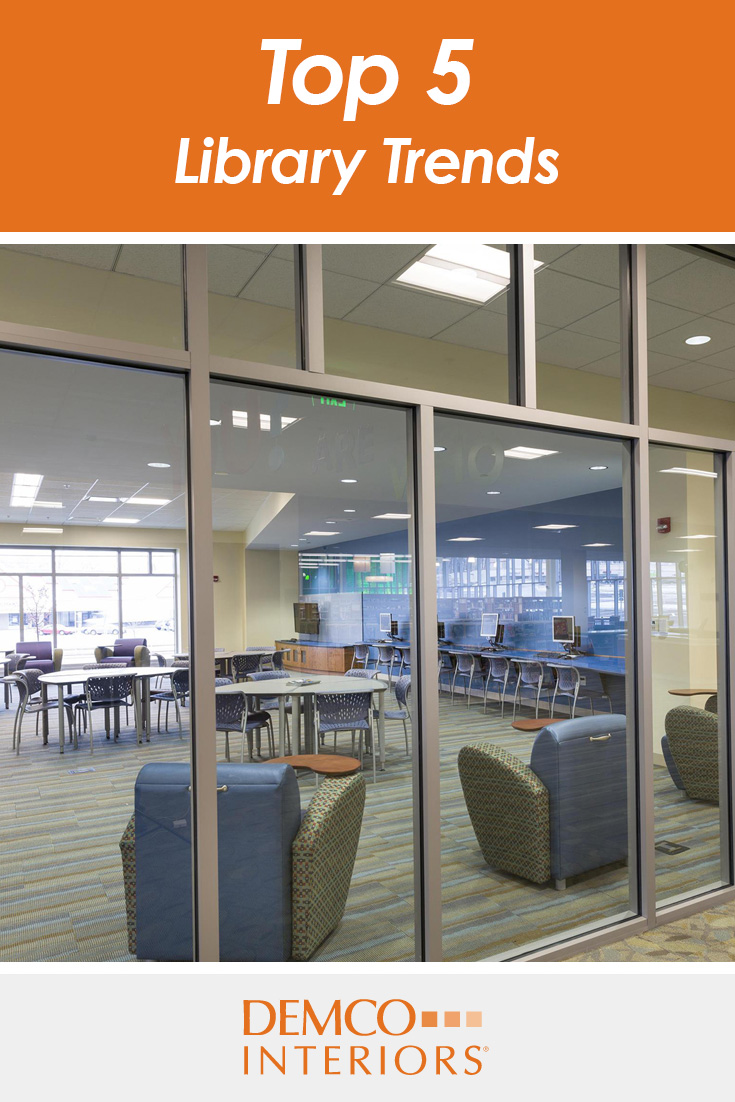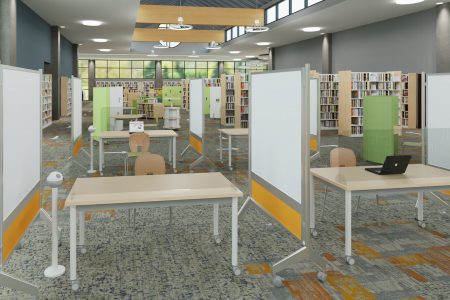Libraries are continually looking to improve and provide great spaces for patrons and staff. Technology is constantly changing, and there are so many facets to library design that library interiors are constantly evolving. Some of the most common trends in library design we’ve seen recently are both technology driven and architecturally driven.
Here are the top 5 trends:
1. Light & Airy Open Spaces
These types of spaces are being emphasized in building design for both new and existing libraries. Sustainable practices and the general trend for healthier lifestyles have driven the demand for more natural light and views to the outside.
Some ways to achieve this are:
- Add or build larger window areas for more daylight. You may need to consider sunshade devices, depending on the façade exposure.
- Build fewer permanent or full-height interior walls.
- Add interior windows to bring light farther into the building while allowing sound separation.
- Lower the library shelving to extend natural daylight farther into the building.
- Instead of using the walls, use color or floor pattern changes to designate or highlight areas.
2. Unfixed Flexible Spaces
Designing spaces with flexibility in mind supports many aspects of successful library design and evolving needs.
- Provide fewer built-in service counters and computer stations or study carrels. Opt for modular furniture pieces to accommodate these functions and allow for future reconfiguration with minimal disruption and cost.
- Consider fewer fixed PC stations and add more laptop or iPad® dispensers. This will create space for powered study tables that can be used by a broader range of patrons, including the BYOD crowd. (Make sure WiFi is available and working well throughout the library.)
- Use mobile service points. These allow staff to occupy areas of the library during times of peak use, but they can be easily folded and moved away at other times.
- Use furniture and shelving to designate spaces without walls. Lower shelving will make it easier for patron wayfinding as well as staff oversight.
- Use mobile furniture and library shelving as a great solution for multi-purpose space needs, like teen and children’s areas, or for small libraries with limited space. Academic libraries can utilize mobile furniture for quick and easy reconfiguration in areas used for impromptu lectures or instruction.
3. Power … Everywhere
Power demands continue to increase across the board and are an important design consideration. Because of emerging technologies, locations where devices are being used continually change, and this creates a demand for multiple types of access to power:
- Powered tables
- Powered lounge furniture
- Charging stations
- Wireless charging areas
Whether renovating or building new, planning for power and data infrastructure is imperative to keep up with the changing demands in a cost-effective way. Here are some common effective solutions:
- Raised access floor systems for new construction incorporate power, data and mechanical systems under the floor panels. One of the many benefits from a system like this is that it allows these components to be relocated without major construction. An additional benefit is that heating and cooling vents up from the floor and efficiently conditions the volume of space where patrons occupy and not the upper volume like traditional ceiling-vented mechanical systems. This creates a more evenly conditioned building.
 Low-profile access floor systems can be a great solution for renovation projects. These systems accommodate power and data to be placed anywhere, with the ability for receptacle relocation. These floor systems generally are 1.67 inches to 3 inches high and require some shallow ramping from areas that cannot be raised, like restrooms and exit stairs.
Low-profile access floor systems can be a great solution for renovation projects. These systems accommodate power and data to be placed anywhere, with the ability for receptacle relocation. These floor systems generally are 1.67 inches to 3 inches high and require some shallow ramping from areas that cannot be raised, like restrooms and exit stairs.- Power devices that can be relocated without major work offer an economic solution for tight budget projects and light renovations; however, they are not as seamless as the access floors. Under-carpet wiring is more economical than low-profile access flooring, but receptacles will sit on top of the floor.
- Power-only solutions include:
- Under-carpet power stations, such as Steelcase Thread
- KI Isle Power Tower
- Charging stations and lockers
4. Collaboration and Study Spaces
These spaces are in demand. Many library designs are incorporating rooms or “rooms within a room” for collaboration and group study spaces. Manufacturers are producing some great solutions for varying degrees of need:
- Demountable partitions or moveable walls work great for the following:
- Makerspaces with accessible wall panels for changing technology upgrades
- Study rooms that feature writable marker board walls
- Acoustic separation
- Freestanding lightweight partitions and screens allow for the following:
- Acoustic separation
- Semi-private spaces
- Changeable configurations
5. Furniture Trends
There is a broad spectrum of furniture trends, but these are some common solutions we’ve been utilizing in our recent library designs:
- Sit-to-stand tables and study carrels are crossing over from office use to libraries. Patrons, students and staff working or studying for long periods of time prefer the option to stand for part of that time.
- Multiple types of furniture for various areas of the library are being specified with castors for easy reconfiguration. Study tables, metal shelving and lounge chairs are the most common.
- Flip-top mobile tables are replacing folding-leg tables in meeting rooms, so one person can easily set up the entire room.
- Study pods, or lounge carrels, are growing in popularity in academic libraries because they create semi-private, focused work areas inside a larger space.
- High-backed lounge seating can create a singular focused space or be grouped together to create a small-group space within a larger open area.
- Collaboration stations that can share content through a WiFi or Bluetooth connection are becoming more common since most personal devices support wireless connections. This allows nearly any powered table to work for collaboration with a monitor. If you have furniture in good condition, an economical approach would be to refurbish existing tables with new power and provide a mobile monitor with storage for the wireless components.
These are just a few of the trends we’re seeing in libraries. It is fantastic that the role of libraries continues to grow in their communities and evolve to better serve their users.
Stephanie Shook, LEED AP BD+C, Interior Designer
Stephanie has been with HBM Architects since 2006. Overall, she has more than 20 years of experience in developing interiors for public spaces. With a focus on public and academic libraries, she leads the development and growth of the firm’s interior design department.
Stephanie translates her clients' needs and vision into an exciting, beautiful and highly functional library space that fits the unique context of each community. Her experience includes library programming, planning, design, finish selection, furniture selection, custom cabinetry design and detailing as well as interiors package coordination, construction administration, installation and project management.
With a strong emphasis on sustainability and integration of LEED ideas and components, HBM’s designs include multi-faceted solutions spanning many styles from historic to contemporary and have been recognized by the American Institute of Architects, Association of Licensed Architects, Urban Libraries Council, Library Journal Magazine and American Libraries Magazine for excellence in design.
Latest posts by Stephanie Shook, LEED AP BD+C, Interior Designer (see all)
- Top 5 Library Design Trends - August 27, 2018
- 5 Library Updates You Can Make on a Budget - August 17, 2017
- 4 Steps to Evaluating Your Library for Updates - August 3, 2017
- 9 Ways to Create a Children’s Area That Keeps Kids Coming Back - January 23, 2017
































